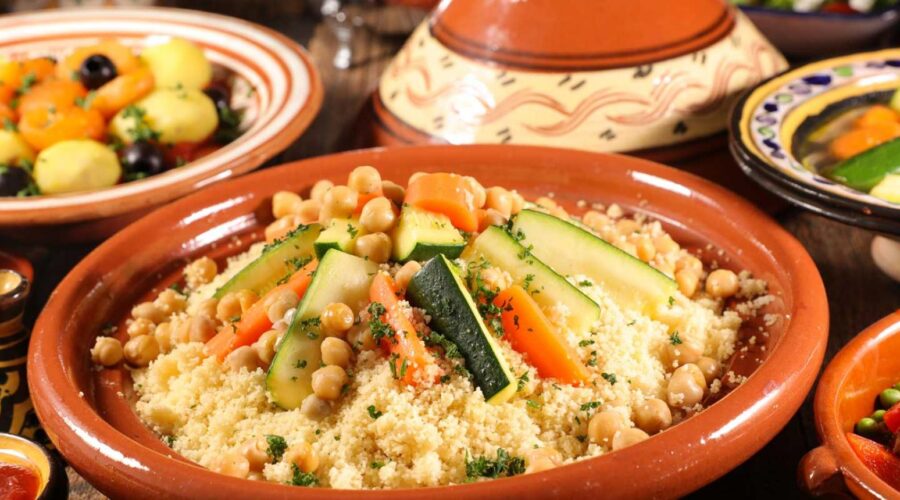Traditional Moroccan Meals
Moroccan cuisine is a vibrant and flavorful mix of Berber, Arab, and Mediterranean influences, with a touch of French and Spanish elements. The country’s rich culinary heritage is reflected in its traditional meals, which are prepared using an array of spices, fresh vegetables, and tender meats. In Agadir, you’ll have the opportunity to experience these traditional dishes, which provide a deep insight into Morocco’s culture and history.
A World of Spices and Aromas
One of the defining features of Moroccan cuisine is its use of spices. Spices such as cumin, cinnamon, saffron, ginger, paprika, turmeric, and the famous ras el hanout (a unique blend of spices) are used in various combinations to create rich, aromatic flavors. These spices not only enhance the taste but also carry cultural significance, as each spice tells a story of Morocco’s trade history and diverse influences.
Tagine: The Heart of Moroccan Cooking
The tagine is perhaps the most iconic Moroccan dish. Named after the traditional clay pot in which it’s cooked, the tagine is a slow-cooked stew made with meat (lamb, chicken, or beef), vegetables, fruits, and a blend of aromatic spices. The cooking process is unique, as the pot’s conical lid traps steam, allowing the ingredients to cook evenly and absorb the flavors fully. Common varieties include chicken with preserved lemons and olives, lamb with prunes, and vegetable tagine for vegetarians. Each region in Morocco has its own version of this dish, making it a true reflection of Moroccan culinary diversity.
Couscous: A Staple of Moroccan Meals
Couscous is another cornerstone of Moroccan meals, typically served on Fridays as a special family meal. It consists of steamed semolina wheat granules and is usually accompanied by a rich, flavorful stew made with meat and vegetables. The dish is often served with lamb, chicken, and a variety of vegetables like carrots, zucchini, and pumpkin. Couscous is traditionally eaten with the hands, and it is an essential part of Moroccan hospitality. In Agadir, you’ll find many restaurants offering different variations of couscous, each with its own unique twist.
Pastilla: A Delightful Pastry
For something sweet and savory, pastilla is a must-try Moroccan dish. Traditionally made with pigeon, pastilla is a delicate pastry filled with meat, almonds, and a blend of spices, then wrapped in layers of thin dough. It is usually sprinkled with powdered sugar and cinnamon, creating a perfect balance of savory and sweet. In Agadir, you may find pastilla made with chicken or seafood, which adds a modern touch to this classic dish.
Harira: A Comforting Soup
Harira is a traditional Moroccan soup made with tomatoes, lentils, chickpeas, and a variety of herbs and spices. It’s often eaten during Ramadan to break the fast, but it’s enjoyed year-round as a hearty meal. The soup is thickened with flour and often served with dates and saffron bread on the side. Harira is considered a comfort food in Morocco, providing warmth and nourishment during colder months.
Mechoui: Slow-Roasted Lamb
A true Moroccan feast, mechoui involves roasting a whole lamb, often in a large pit. The lamb is seasoned with cumin, garlic, and other spices, giving it a tender, melt-in-your-mouth texture. Mechoui is typically served at celebrations and large gatherings and is accompanied by flatbread, which is used to scoop up the meat. It’s a communal dish, shared by family and friends, making it a great way to experience Moroccan hospitality.
B’stilla: Sweet and Savory Pie
B’stilla, a rich pastry, is often served at special occasions. Traditionally made with pigeon meat, though chicken or seafood can be used, it is a mixture of tender meat, eggs, and almonds wrapped in flaky pastry. The pie is sweetened with powdered sugar and cinnamon, which balances the savory flavors of the meat. It’s a beautiful dish that reflects Morocco’s fusion of sweet and savory tastes.
Mint Tea: The Moroccan Tradition
No Moroccan meal is complete without a glass of mint tea. This tea is made from green tea steeped with fresh mint leaves and sweetened generously with sugar. It is an essential part of Moroccan hospitality, often served with pastries or nuts. Mint tea is not only a drink but a symbol of friendship and warmth, and in Agadir, you’ll be invited to share a glass of this refreshing tea with locals during your visit.
Traditional Moroccan Sweets
Moroccan desserts are a sweet ending to a flavorful meal. Chebakia, kaab el ghazal (gazelle horns), and baklava are just a few of the treats you’ll find in local markets. These sweets are often made with honey, almonds, and sesame seeds, offering a rich and aromatic experience. They are traditionally served with mint tea and are perfect for indulging your sweet tooth.
Why Choose Traditional Moroccan Meals?
- Cultural Immersion: Eating traditional Moroccan meals allows you to deeply connect with the culture and history of Morocco.
- Flavorful and Diverse: The combination of spices, fresh ingredients, and unique cooking methods creates rich and diverse flavors.
- Social Experience: Moroccan meals are often shared with family and friends, making them an opportunity to experience Moroccan hospitality.
- A Feast for the Senses: From the rich aromas of spices to the colorful presentation, traditional Moroccan meals are a sensory delight.


